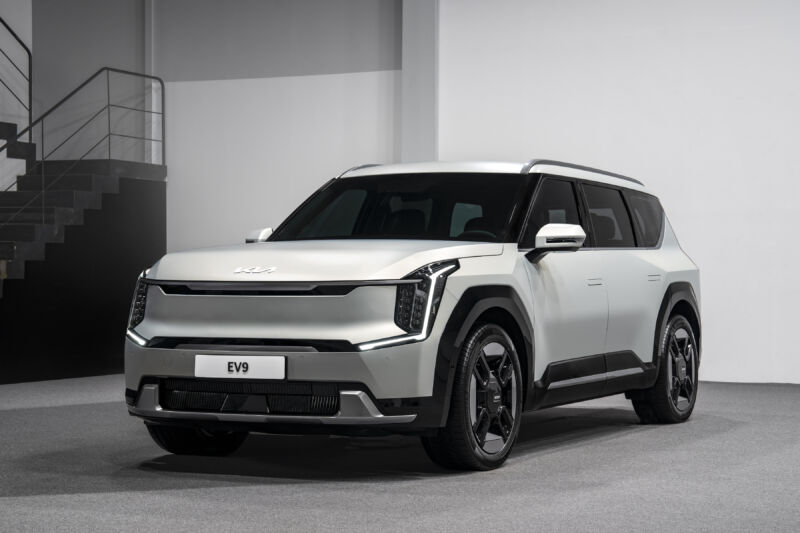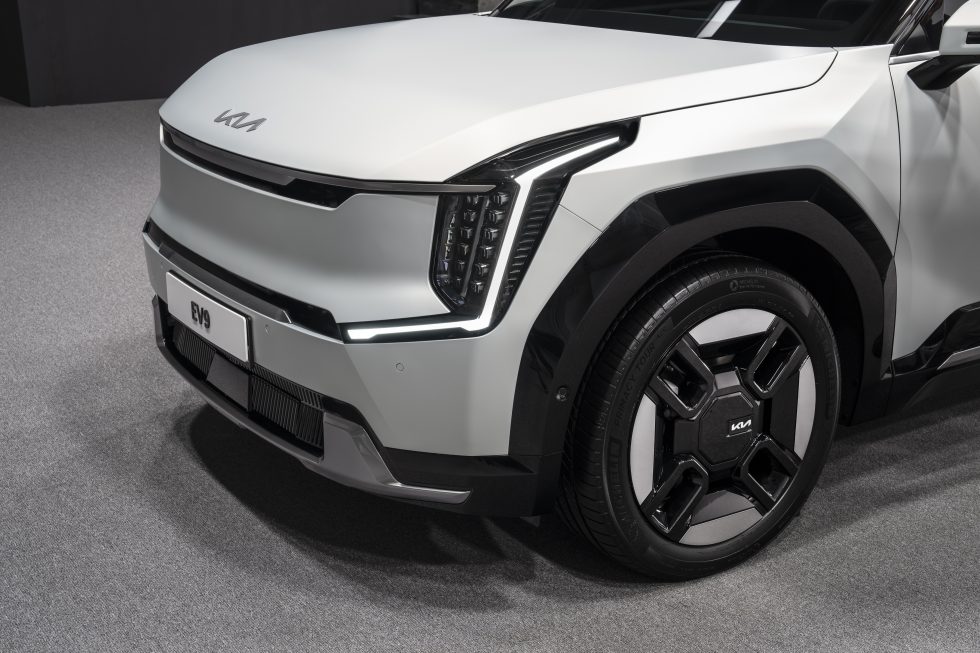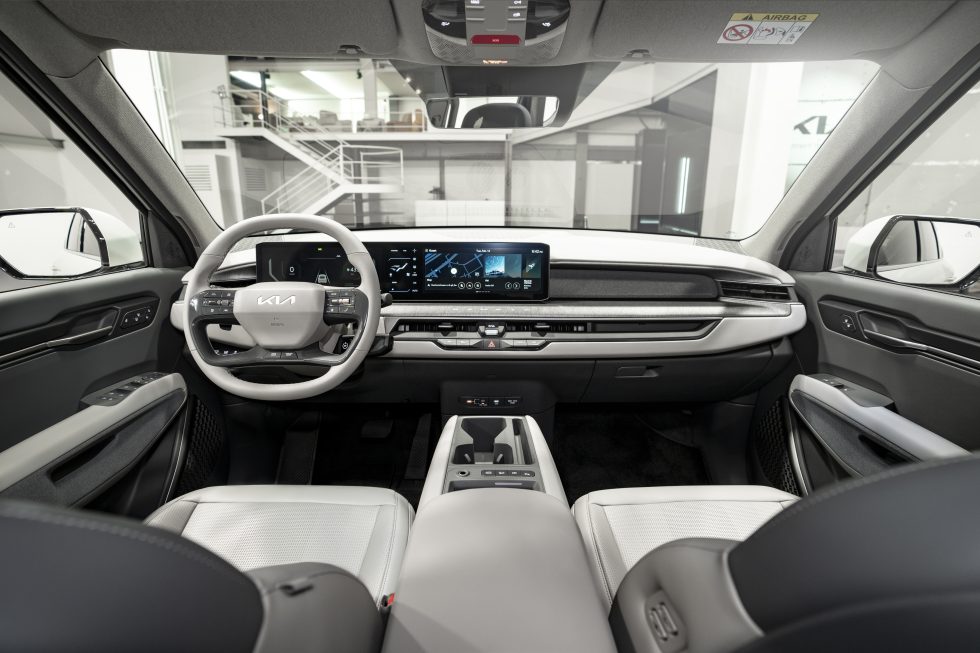
Kia
SEOUL, KOREA—In 2021, Kia used that year’s Los Angeles Auto Show to debut a new electric concept called the EV9. Today, Kia took the wraps off the production version, which goes on sale in the second half of this year. The production EV9 is definitely an evolution of the show car but with some of the concept’s more outrageous design details toned down a bit.
It’s a large three-row SUV that uses Kia and Hyundai’s advanced new electric vehicle platform called E-GMP, which has already impressed us and many others in new EVs like the Hyundai Ioniq 5 and Kia’s EV6. Those two are smaller crossovers, but the EV9 is bringing that 800 V technology to a larger vehicle, one that should be well-suited to North American tastes.
-
The production EV9 has much less scalloped doors than the concept we saw in 2021. It’s a little shorter than the Kia Telluride but with a much longer wheelbase.
KiaPublicité -
Kia maintained an upright stance for the EV9’s exterior to maximize interior space and keep an iconic SUV shape.
Kia
« The journey over the last couple of years to get to where we are now in terms of design could only happen when designers and brands work together, and this design philosophy—opposites united—is very much based on that idea of movement and richness through movement, » explained Karim Habib, head of Kia Global Design. « It’s about the juxtaposition of [a] man-made structure in nature and how that contrast actually can be very beautiful or even within nature itself. »
« As one example, you’ll see that we have these very high, very boxy, triangular fenders, » Habib said. « But at the same time, we have a very sleek body with a very low center of gravity. A low center of gravity for an SUV is a bit unusual. We also had a pretty low belt line, so a lot of glass. »
The most obvious changes are more normal headlights at the front—although the distinctive vertical daylight running lights made the transition from concept to production unscathed, evoking Kia’s « tiger nose » grille without an actual grille. Size-wise, it’s three inches shorter in length than the Kia Telluride SUV, albeit with a significantly longer wheelbase, and it’s an inch taller and three inches wider than the conventionally powered Telluride.

Kia
Interior space was an important consideration. « This is on our dedicated E-GMP architecture, » Habib explained. « So we wanted to take full advantage of that with a flat floor. You’ll see on the dashboard, on the doors, on the console, we’re not just working with the object itself, but we really tried to work on the spacing between the objects, » he said, referring to the use of negative space juxtaposed with the screens on the EV9’s dash.
That interior is much more conventional than the EV9 concept car’s, particularly the steering wheel, which is now completely normal compared to the rhomboid device we saw in 2021.
Refreshingly, there is not a single bit of piano-black trim anywhere in the interior.

KIa
« We have consciously not used piano black, » explained Jochen Paesen, vice president of interior design at Kia. « We’re using a middle gray; it’s in both matte and gloss. But as you see, the combination between matte and gloss is what makes it feel refined rather than just having a lot of gloss material. So it gives you a modernity, we feel. The black gloss has had its time—we can do without it, » Paesen told Ars.
« What we tried to do with the cluster [was put] all the digital, visual aspects in one line to make sure they don’t take your eye off the road too much, » Paesen said.
Kia stuck with a rather upright design for the EV9, one that minimizes the expanse of space between the base of the windshield and the steering wheel. The payoff was more interior room for all three rows. « We wanted to create something that is still, from the exterior, an SUV. But because of the flat floor, because of the amount of space you have here—you know, a little bit more upright—you really maximize the interior space, » Paesen said.
-
The EV9’s middle row can rotate 180 degrees.
Kia -
You’d definitely be able to fit some trombones in this EV.
Kia
Creating a less-distracting environment for the driver was also important to the Kia design team. « We’ve simplified the [human-machine interface]. We wanted to make sure that, you know, everything is at your eye point; you don’t have to look too far down, so your eyes can stay on the road, » Paesen said.
« We simplified the interaction so there are physical [buttons], there are digital [buttons], but we wanted them to be relatively high, » he continued. « So from the corner of the eye, you’re actually able to interact, and we wanted to do that because we think it’s a better interaction, but also it frees up a lot of space in the interior. So we have all of this space that’s open, free. We have more creative freedom for the design around it. And therefore we can create quite unique interiors. Moving forward, this will become a constant throughout our EVs. »
When does it arrive, and how much will it cost?
It’s a bit too soon for Kia to officially announce specs or pricing for the EV9, but in January, Car and Driver got ahold of a Kia document purporting to show some of those details. There will be five trims in total, with prices starting at $56,000 for a base rear-wheel drive model with 200 hp (150 kW) and a 220-mile (354-km) range. This may well use the smaller of the two E-GMP battery packs.
A longer-range rear-wheel drive EV9 will probably use the larger battery pack to achieve 290 miles of range (467 km), plus the ability to tow up to 2,000 lbs (907 kg), for $61,000.
Car and Driver thinks you’ll need to pay $63,000 for an all-wheel-drive EV9, which boasts twice the power. Range is supposedly around 260 miles (418 km) for this variant, and it can tow loads of up to 3,500 lb (1,588 kg).
The final two trims are slated to cost approximately $68,000 and $73,000—these both have a range of 240 miles (386 km), presumably due to their larger 20- or 21-inch wheels (which replace the standard 19-inch wheels). The most expensive EV9 also has a 4,500 lb (2,041 kg) tow rating.
At launch, the EV9 is unlikely to qualify for the federal clean vehicle tax credit, as the vehicle will be built in Korea, but the Korea Economic Daily reported that Kia is planning to start North American production in Georgia in 2024. As long as the EV9’s battery pack contains enough domestic content, that should qualify it for a credit of up to $7,500.










